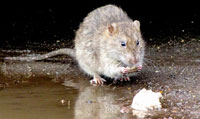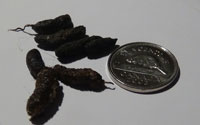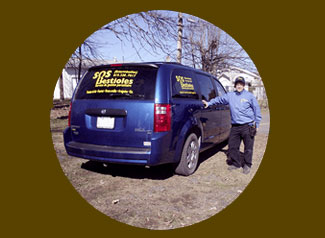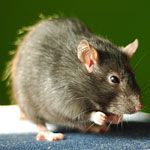What does it look like?
Its real name is Rattus norvegicus but it can have several nicknames : Norway Rat, Grey Rat, Water Rat, Brown Rat, Sewar Rat, House Rat.
 The adult rat is 30-45 cm long with its tail. The tail is 15-20 cm long. The body is thin and elongated. It is soft and flexible, it can fit in a hole the size of 1$. The fur is dark brown on the back and grey-whitish on the tummy. It has tiny hidden ears. The eyes are small and adapted to aquatic life. The nose is thick and square-shaped.
The adult rat is 30-45 cm long with its tail. The tail is 15-20 cm long. The body is thin and elongated. It is soft and flexible, it can fit in a hole the size of 1$. The fur is dark brown on the back and grey-whitish on the tummy. It has tiny hidden ears. The eyes are small and adapted to aquatic life. The nose is thick and square-shaped.
The rat has long vibriss sensory hair on its nose. The tail is round, it has rings and scales. The tail is darker on its top. The tail’s length is shorter then half of the rat’s body length. The rat weights between 195-500g.
Call an expert Ask an expert » Get a quick quote »Does the Rat represent any risk for my and my belongings?
The answer to both questions is yes. The rat contaminates the food and any surface it comes in contact with, through its saliva, paws, urine and droopings. The Norway Rat can cause considerable damage to structures and material. The rat has evergrowing incisives.
The rat has to gnaw constantly to wear its front teeth. The rat can gnaw alluminum, wood, plastic, foam, insulation wool, drywall, brick and asphalt.
Rats can be responsible of :
- Electrical fires from short-circuit
- Damage sofas, mattresses, curtains
- Spread diseases, bacteria and viruses
- Eat and contaminate our food
- Eat and contaminate pet food
- Spread leptospirosis through its urine and droopings; fatal disease for dogs
- Bring parasites such as : lices, fleas, mites and ticks
- Cause fear, phobia and anxiety
What are the signs of its presence?
The signs of its presence are usually quite discrete. The rat is small and nocturnal. It has cognitive abilities beyond the mouse and can hide from us. Sooner or later you may hear noise at night : scratching, ligth squealing sounds under the sink, between walls, in the roof or in the attick. You may come across it at night, when the rat is looking for food.
 The rat’s droopings are black and shiny, 10-19mm long. In dusty spots, one can notice tail marks (4-5 mm wide) or paw marks (2-4 cm wide). The rat has burrows outside, 8-10 cm in diameter. You may find teeth marks (3-4 mm wide) on objects. There could be fat stains along baseboards, around entry holes, behind electrical appliances, etc. Those fat stains are caused by the rat rubbing against surfaces; the rat has an oily fur. You may also find tears on a sofa, carpet, curtain. You might also find paper pieces, holes in carboard boxes, etc.
The rat’s droopings are black and shiny, 10-19mm long. In dusty spots, one can notice tail marks (4-5 mm wide) or paw marks (2-4 cm wide). The rat has burrows outside, 8-10 cm in diameter. You may find teeth marks (3-4 mm wide) on objects. There could be fat stains along baseboards, around entry holes, behind electrical appliances, etc. Those fat stains are caused by the rat rubbing against surfaces; the rat has an oily fur. You may also find tears on a sofa, carpet, curtain. You might also find paper pieces, holes in carboard boxes, etc.
What should I do if I have Rats?
The rat is the most intelligent rodent that lives around humans. If there is only one, you might be able to catch it. If there are several of them, you will need to get help.
Poisons should not be used in the house. The rat is too big to use poison with since there will be a strong and long-lasting decomposition smell. A rat is 10-15 times heavier than a mouse. It can take up to 1 month for a rat to decompose.
If you think you have rats, call a pest control specialist as soon as possible. Do not try to catch them yourself since they will become suspicious of any trap and will be harder to catch. Our biologist has specific and thorough techniques how to catch rats, taking into account their behavior.
Our biologist will analyze the problem to find the origin of the rat infestation. He will start early intervention and eliminate rats. Our pest control specialist will give you tips how to prevent a re-occurrence.
Call an expert Ask an expert » Get a quick quote »


